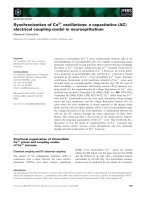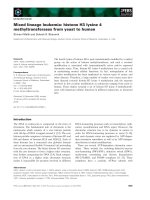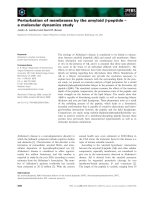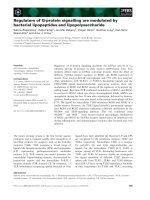Tài liệu Báo cáo khoa học: "How spoken language corpora can refine current speech motor training methodologies" pptx
Bạn đang xem bản rút gọn của tài liệu. Xem và tải ngay bản đầy đủ của tài liệu tại đây (453.78 KB, 6 trang )
Proceedings of the ACL 2010 Student Research Workshop, pages 37–42,
Uppsala, Sweden, 13 July 2010.
c
2010 Association for Computational Linguistics
How spoken language corpora can refine
current speech motor training methodologies
Daniil Umanski, Niels O. Schiller
Leiden Institute for Brain and Cognition
Leiden University, The Netherlands
Federico Sangati
Institute for Logic,
Language and Computation
University of Amsterdam, the Netherlands
Abstract
The growing availability of spoken lan-
guage corpora presents new opportunities
for enriching the methodologies of speech
and language therapy. In this paper, we
present a novel approach for construct-
ing speech motor exercises, based on lin-
guistic knowledge extracted from spoken
language corpora. In our study with the
Dutch Spoken Corpus, syllabic inventories
were obtained by means of automatic syl-
labification of the spoken language data.
Our experimental syllabification method
exhibited a reliable performance, and al-
lowed for the acquisition of syllabic tokens
from the corpus. Consequently, the syl-
labic tokens were integrated in a tool for
clinicians, a result which holds the poten-
tial of contributing to the current state of
speech motor training methodologies.
1 Introduction
Spoken language corpora are often accessed by
linguists, who need to manipulate specifically de-
fined speech stimuli in their experiments. How-
ever, this valuable resource of linguistic informa-
tion has not yet been systematically applied for
the benefit of speech therapy methodologies. This
is not surprising, considering the fact that spoken
language corpora have only appeared relatively re-
cently, and are still not easily accessible outside
the NLP community. Existing applications for
selecting linguistic stimuli, although undoubtedly
useful, are not based on spoken language data,
and are generally not designed for utilization by
speech therapists per se (Aichert et al., 2005). As
a first attempt to bridge this gap, a mechanism is
proposed for utilizing the relevant linguistic in-
formation to the service of clinicians. In coor-
dination with speech pathologists, the domain of
speech motor training was identified as an appro-
priate area of application. The traditional speech
motor programs are based on a rather static inven-
tory of speech items, and clinicians do not have
access to a modular way of selecting speech tar-
gets for training.
Therefore, in this project, we deal with develop-
ing an interactive interface to assist speech thera-
pists with constructing individualized speech mo-
tor practice programs for their patients. The prin-
cipal innovation of the proposed system in re-
gard to existing stimuli selection applications is
twofold: first, the syllabic inventories are derived
from spoken word forms, and second, the selec-
tion interface is integrated within a broader plat-
form for conducting speech motor practice.
2 Principles of speech motor practice
2.1 Speech Motor Disorders
Speech motor disorders (SMD) arise from neuro-
logical impairments in the motor systems involved
in speech production. SMD include acquired and
developmental forms of dysarthria and apraxia of
speech. Dysarthria refers to the group of disor-
ders associated with weakness, slowness and in-
ability to coordinate the muscles used to produce
speech (Duffy, 2005). Apraxia of speech (AOS)
is referred to the impaired planning and program-
ming of speech (Ziegler , 2008). Fluency dis-
orders, namely stuttering and cluttering, although
not always classified as SMD, have been exten-
sively studied from the speech motor skill perspec-
tive (Van Lieshout et al., 2001).
2.2 Speech Motor Training
The goal of speech therapy with SMD patients is
establishing and maintaining correct speech mo-
tor routines by means of practice. The process of
learning and maintaining productive speech mo-
tor skills is referred to as speech motor training.
37
An insightful design of speech motor training ex-
ercises is crucial in order to achieve an optimal
learning process, in terms of efficiency, retention,
and transfer levels (Namasivayam, 2008).
Maas et al. (2008) make the attempt to relate find-
ings from research on non-speech motor learning
principles to the case of speech motor training.
They outline a number of critical factors in the de-
sign of speech motor exercises. These factors in-
clude the training program structure, selection of
speech items, and the nature of the provided feed-
back.
It is now generally agreed that speech motor exer-
cises should involve simplified speech tasks. The
use of non-sense syllable combinations is a gener-
ally accepted method for minimizing the effects of
higher-order linguistic processing levels, with the
idea of tapping as directly as possible to the motor
component of speech production (Smits-Bandstra
et al., 2006) .
2.3 Selection of speech items
The main considerations in selecting speech items
for a specific patient are functional relevance and
motor complexity. Functional relevance refers
to the specific motor, articulatory or phonetic
deficits, and consequently to the treatment goals
of the patient. For example, producing correct
stress patterns might be a special difficulty for one
patient, while producing consonant clusters might
be challenging for another. Relative motor com-
plexity of speech segments is much less defined in
linguistic terms than, for example, syntactic com-
plexity (Kleinow et al., 2000). Although the part-
whole relationship, which works well for syntactic
constructions, can be applied to syllabic structures
as well (e.g., ’flake’ and ’lake’), it may not be the
most suitable strategy.
However, in an original recent work, Ziegler
presented a non-linear probabilistic model of
the phonetic code, which involves units from a
sub-segmental level up to the level of metrical
feet (Ziegler , 2009). The model is verified on
the basis of accuracy data from a large sample of
apraxic speakers, and thus provides a quantitive
index of a speech segment’s motor complexity.
Taken together, it is evident that the task of se-
lecting sets of speech items for an individualized,
optimal learning process is far from obvious, and
much can be done to assist the clinicians with go-
ing through this step.
3 The role of the syllable
The syllable is the primary speech unit used in
studies on speech motor control (Namasivayam,
2008). It is also the basic unit used for con-
structing speech items in current methodologies
of speech motor training (Kent, 2000). Since
the choice of syllabic tokens is assumed to affect
speech motor learning, it would be beneficial to
have access to the syllabic inventory of the spoken
language. Besides the inventory of spoken sylla-
bles, we are interested in the distribution of sylla-
bles across the language.
3.1 Syllable frequency effects
The observation that syllables exhibit an exponen-
tial distribution in English, Dutch and German has
led researchers to infer the existence of a ’men-
tal syllabary’ component in the speech production
model (Schiller et al., 1996). Since this hypothesis
assumes that production of high frequency sylla-
bles relies on highly automated motor gestures, it
bears direct consequences on the utility of speech
motor exercises. In other words, manipulating syl-
lable sets in terms of their relative frequency is ex-
pected to have an effect on the learning process of
new motor gestures. This argument is supported
by a number of empirical findings. In a recent
study, Staiger et al. report that syllable frequency
and syllable structure play a decisive role with re-
spect to articulatory accuracy in the spontaneous
speech production of patients with AOS (Staiger
et al., 2008). Similarly, (Laganaro, 2008) con-
firms a significant effect of syllable frequency on
production accuracy in experiments with speakers
with AOS and speakers with conduction aphasia.
3.2 Implications on motor learning
In that view, practicing with high-frequency sylla-
bles could promote a faster transfer of skills to ev-
eryday language, as the most ’required’ motor ges-
tures are being strengthened. On the other hand,
practicing with low-frequency syllables could po-
tentially promote plasticity (or ’stretching’ ) of the
speech motor system, as the learner is required to
assemble motor plans from scratch, similar to the
process of learning to pronounce words in a for-
eign language. In the next section, we describe
our study with the Spoken Dutch Corpus, and il-
lustrate the performed data extraction strategies.
38
4 A study with the Spoken Dutch Corpus
The Corpus Gesproken Nederlands (CGN) is a
large corpus of spoken Dutch
1
. The CGN con-
tains manually verified phonetic transcriptions of
53,583 spoken forms, sampled from a wide vari-
ety of communication situations. A spoken form
reports the phoneme sequence as it was actually
uttered by the speaker as opposed to the canonical
form, which represents how the same word would
be uttered in principle.
4.1 Motivation for accessing spoken forms
In contrast to written language corpora, such as
CELEX (Baayenet al., 1996), or even a corpus
like TIMIT (Zue et al., 1996), in which speak-
ers read prepared written material, spontaneous
speech corpora offer an access to an informal, un-
scripted speech on a variety of topics, including
speakers from a range of regional dialects, age and
educational backgrounds.
Spoken language is a dynamic, adaptive, and gen-
erative process. Speakers most often deviate from
the canonical pronunciation, producing segment
reductions, deletions, insertions and assimilations
in spontaneous speech (Mitterer, 2008). The work
of Greenberg provides an in-depth account on the
pronunciation variation in spoken English. A de-
tailed phonetic transcription of the Switchboard
corpus revealed that the spectral properties of
many phonetic elements deviate significantly from
their canonical form (Greenberg, 1999).
In the light of the apparent discrepancy between
the canonical forms and the actual spoken lan-
guage, it becomes apparent that deriving syllabic
inventories from spoken word forms will approxi-
mate the reality of spontaneous speech production
better than relying on canonical representations.
Consequently, it can be argued that clinical ap-
plications will benefit from incorporating speech
items which optimally converge with the ’live’ re-
alization of speech.
4.2 Syllabification of spoken forms
The syllabification information available in the
CGN applies only to the canonical forms of words,
and no syllabification of spoken word forms exists.
The methods of automatic syllabification have
been applied and tested exclusively on canonical
word forms (Bartlett, 2007). In order to obtain
the syllabic inventory of spoken language per se,
1
(see />a preliminary study on automatic syllabification
of spoken word forms has been carried out. Two
methods for dealing with the syllabification task
were proposed, the first based on an n-gram model
defined over sequences of phonemes, and the sec-
ond based on statistics over syllable units. Both
algorithms accept as input a list of possible seg-
mentations of a given phonetic sequence, and re-
turn the one which maximizes the score of the spe-
cific function they implement. The list of possible
segmentations is obtained by exhaustively gener-
ating all possible divisions of the sequence, satis-
fying the condition of keeping exactly one vowel
per segment.
4.3 Syllabification Methods
The first method is a reimplementation of the work
of (Schmid et al., 2007). The authors describe the
syllabification task as a tagging problem, in which
each phonetic symbol of a word is tagged as ei-
ther a syllable boundary (‘B’) or as a non-syllable
boundary (‘N’). Given a set of possible segmenta-
tions of a given word, the aim is to select the one,
viz. the tag sequence
ˆ
b
n
1
, which is more proba-
ble for the given phoneme sequence p
n
1
, as shown
in equation (1). This probability in equations (3)
is reduced to the joint probability of the two se-
quences: the denominator of equation (2) is in fact
constant for the given list of possible syllabifica-
tions, since they all share the same sequence of
phonemes. Equation (4) is obtained by introduc-
ing a Markovian assumption of order 3 in the way
the phonemes and tags are jointly generated
ˆ
b
n
1
= arg max
b
n
1
P (b
n
1
|p
n
1
) (1)
= arg max
b
n
1
P (b
n
1
, p
n
1
)/P (p
n
1
) (2)
= arg max
b
n
1
P (b
n
1
, p
n
1
) (3)
= arg max
b
n
1
n+1
i=1
P (b
i
, p
i
|b
i−1
i−3
, p
i−1
i−3
) (4)
The second syllabification method relies on
statistics over the set of syllables unit and bi-
gram (bisegments) present in the training corpus.
Broadly speaking, given a set of possible segmen-
tations of a given phoneme sequence, the algo-
rithm, selects the one which maximizes the pres-
ence and frequency of its segments.
39
Corpus
Phonemes Syllables
Boundaries Words Boundaries Words
CGN Dutch 98.62 97.15 97.58 94.99
CELEX Dutch 99.12 97.76 99.09 97.70
CELEX German 99.77 99.41 99.51 98.73
CELEX English 98.86 97.96 96.37 93.50
Table 1: Summary of syllabification results on canonical word forms.
4.4 Results
The first step involved the evaluation of the two
algorithms on syllabification of canonical word
forms. Four corpora comprising three different
languages (English, German, and Dutch) were
evaluated: the CELEX2 corpora (Baayenet al.,
1996) for the three languages, and the Spoken
Dutch Corpus (CGN). All the resources included
manually verified syllabification transcriptions. A
10-fold cross validation on each of the corpora was
performed to evaluate the accuracy of our meth-
ods. The evaluation is presented in terms of per-
centage of correct syllable boundaries
2
, and per-
centage of correctly syllabified words.
Table 1 summarizes the obtained results. For the
CELEX corpora, both methods produce almost
equally high scores, which are comparable to the
state of the art results reported in (Bartlett, 2007).
For the Spoken Dutch Corpus, both methods
demonstrate quite high scores, with the phoneme-
level method showing an advantage, especially
with respect to correctly syllabified words.
4.5 Data extraction
The process of evaluating syllabification of spo-
ken word forms is compromised by the fact that
there exists no gold annotation for the pronuncia-
tion data in the corpus. Therefore, the next step
involved applying both methods on the data set
and comparing the two solutions. The results re-
vealed that the two algorithms agree on 94.29%
of syllable boundaries and on 90.22% of whole
word syllabification. Based on the high scores re-
ported for lexical word forms syllabification, an
agreement between both methods most probably
implies a correct solution. The ’disagreement’ set
can be assumed to represent the class of ambigu-
ous cases, which are the most problematic for au-
tomatic syllabification. As an example, consider
2
Note that recall and precision coincide since the number
of boundaries (one less than the number of vowels) is con-
stant for different segmentations of the same word.
the following pair of possible syllabification, on
which the two methods disagree: ’bEl-kOm-pjut’
vs ’bEl-kOmp-jut’
3
.
Motivated by the high agreement score, we have
applied the phoneme-based method on the spo-
ken word forms in the CGN, and compiled a syl-
labic inventory. In total, 832,236 syllable tokens
were encountered in the corpus, of them 11,054
unique syllables were extracted and listed. The
frequencies distribution of the extracted syllabary,
as can be seen in Figure 1, exhibits an exponential
curve, a result consistent with earlier findings re-
ported in (Schiller et al., 1996). According to our
statistics, 4% of unique syllable tokens account for
80% of all extracted tokens, and 10% of unique
syllables account for 90% respectively. For each
extracted syllable, we have recorded its structure,
frequency rank, and the articulatory characteristics
of its consonants. Next, we describe the speech
items selection tool for clinicians.
Figure 1: Syllable frequency distribution over the
spoken forms in the Dutch Spoken Corpus.
The x-axis represents 625 ranked frequency bins.
The y-axis plots the total number of syllable to-
kens extracted for each frequency bin.
3
A manual evaluation of the disagreement set revealed a
clear advantage for the phoneme-based method
40
5 An interface for clinicians
In order to make the collected linguistic informa-
tion available for clinicians, an interface has been
built which enables clinicians to compose individ-
ual training programs. A training program con-
sists of several training sessions, which in turn
consists of a number of exercises. For each ex-
ercise, a number of syllable sets are selected, ac-
cording to the specific needs of the patient. The
main function of the interface, thus, deals with
selection of customized syllable sets, and is de-
scribed next. The rest of the interface deals with
the different ways in which the syllable sets can
be grouped into exercises, and how exercises are
scheduled between treatment sessions.
5.1 User-defined syllable sets
The process starts with selecting the number of
syllables in the current set, a number between one
and four. Consequently, the selected number of
’syllable boxes’ appear on the screen. Each box
allows for a separate configuration of one syllable
group. As can be seen in Figure 2, a syllable box
contains a number of menus, and a text grid at the
bottom of the box.
Figure 2: A snapshot of the part of the interface
allowing configuration of syllable sets
Here follows the list of the parameters which the
user can manipulate, and their possible values:
• Syllable Type
4
• Syllable Frequency
5
4
CV, CVC, CCV, CCVC, etc.
5
Syllables are divided in three rank groups - high,
medium, and low frequency.
• Voiced - Unvoiced consonant
6
• Manner of articulation
7
• Place of articulation
8
Once the user selects a syllable type, he/she can
further specify each consonant within that syllable
type in terms of voiced/unvoiced segment choice
and manner and place of articulation. For the sake
of simplicity, syllable frequency ranks have been
divided in three rank groups. Alternatively, the
user can bypass this criterion by selecting ’any’.
As the user selects the parameters which define the
desired syllable type, the text grid is continuously
filled with the list of syllables satisfying these cri-
teria, and a counter shows the number of syllables
currently in the grid.
Once the configuration process is accomplished,
the syllables which ’survived’ the selection will
constitute the speech items of the current exercise,
and the user proceeds to select how the syllable
sets should be grouped, scheduled and so on.
6 Final remarks
6.1 Future directions
A formal usability study is needed in order to
establish the degree of utility and satisfaction with
the interface. One question which demands inves-
tigation is the degrees of choice that the selection
tool should provide. With too many variables
and hinges of choice, the configuration process
for each patient might become complicated and
time consuming. Therefore, a usability study
should provide guidelines for an optimal design
of the interface, so that its utility for clinicians is
maximized.
Furthermore, we plan to integrate the proposed
interface within an computer-based interactive
platform for speech therapy. A seamless integra-
tion of a speech items selection module within
biofeedback games for performing exercises with
these items seems straight forward, as the selected
items can be directly embedded (e.g., as text
symbols or more abstract shapes) in the graphical
environment where the exercises take place.
6
when applicable
7
for a specific consonant. Plosives, Fricatives, Sonorants
8
for a specific consonant. Bilabial, Labio-Dental, Alveo-
lar, Post-Alveolar, Palatal, Velar, Uvular, Glottal
41
Acknowledgments
This research is supported with the ’Mosaic’ grant
from The Netherlands Organisation for Scientific
Research (NWO). The authors are grateful for
the anonymous reviewers for their constructive
feedback.
References
Aichert, I., Ziegler, W. 2004. Syllable frequency and
syllable structure in apraxia of speech. Brain and
Language, 88, 148-159.
Aichert, I., Marquardt, C., Ziegler, W. 2005. Fre-
quenzen sublexikalischer Einheiten des Deutschen:
CELEX-basierte Datenbanken. Neurolinguistik, 19,
55-81
Baayen R.H., Piepenbrock R. and Gulikers L. 1996.
CELEX2. Linguistic Data Consortium, Philadel-
phia.
Bartlett, S. 2007. Discriminative approach to auto-
matic syllabication. Masters thesis, Departmentof-
Computing Science, University of Alberta.
Duffy, J.R 2005. Motor speech disorder: Substrates,
Differential Diagnosis, and Management. (2nd Ed.)
507-524. St. Louis, MO: Elsevier Mosby
Greenberg, S. 1999. Speaking in shorthanda syllable-
centric perspective for understanding pronunciation
variation. Speech Comm., 29(2-4):159-176
Kent, R. 2000. Research on speech motor control
and its disorders, a review and prospectives. Speech
Comm., 29(2-4):159-176 J.
Kleinow, J., Smith, A. 2000. Inuences of length and
syntactic complexity on the speech motor stability
of the uent speech of adults who stutter. Journal
of Speech, Language, and Hearing Research, 43,
548559.
Laganaro, M. 2008. Is there a syllable frequency effect
in aphasia or in apraxia of speech or both? Aphasi-
ology, Volume 22, Number 11, November 2008 , pp.
1191-1200(10)
Maas, E., Robin, D.A., Austermann Hula, S.N., Freed-
man, S.E., Wulf, G., Ballard, K.J., Schmidt, R.A.
2008. Principles of Motor Learning in Treatment
of Motor Speech Disorders American Journal of
Speech-Language Pathology, 17, 277-298.
Mitterer, H. 2008. How are words reduced in sponta-
neous speech? In A. Botinis (Ed.), Proceedings of
the ISCA Tutorial and Research Workshop on Ex-
perimental Linguistics (pages 165-168). University
of Athens.
Namasivayam, A.K., van Lieshout, P. 2008. Investi-
gating speech motor practice and learning in people
who stutter Journal of Fluency Disorders 33 (2008)
3251
Schiller, N. O., Meyer, A. S., Baayen, R. H., Levelt, W.
J. M. 1996. A Comparison of Lexeme and Speech
Syllables in Dutch. Journal of Quantitative Linguis-
tics, 3, 8-28.
Schmid H., M
¨
obius B. and Weidenkaff J. 2007. Tag-
ging Syllable Boundaries With Joint N-Gram Mod-
els. Proceedings of Interspeech-2007 (Antwerpen),
pages 2857-2860.
Smits-Bandstra, S., DeNil, L. F., Saint-Cyr, J. 2006.
Speech and non-speech sequence skill learning in
adults who stutter. Journal of Fluency Disorders,
31,116136.
Staiger, A., Ziegler, W. 2008. Syllable frequency and
syllable structure in the spontaneous speech produc-
tion of patients with apraxia of speech. Aphasiol-
ogy, Volume 22, Number 11, November 2008 , pp.
1201-1215(15)
Tjaden, K. 2000. Exploration of a treatment technique
for prosodic disturbance following stroke training.
Clinical Linguistics and Phonetics 2000, Vol. 14,
No. 8, Pages 619-641
Riley, J., Riley, G. 1995. Speech motor improvement
program for children who stutter. In C.W. Stark-
weather, H.F.M. Peters (Eds.), Stuttering (pp.269-
272) New York: Elsevier
Van Lieshout, P. H. H. M. 2001. Recent developments
in studies of speech motor control in stuttering. In B.
Maassen, W. Hulstijn, R. D. Kent, H. F. M. Peters,
P. H. H. M. Van Lieshout (Eds.), Speech motor con-
trol in normal and disordered speech(pp. 286290).
Nijmegen, The Netherlands:Vantilt.
Ziegler W. 2009. Modelling the architecture of pho-
netic plans: Evidence from apraxia of speech. Lan-
guage and Cognitive Processes 24, 631 - 661
Ziegler W. 2008. Apraxia of speech. In: Goldenberg
G, Miller B (Eds.), Handbook of Clinical Neurology,
Vol. 88 (3rd series), pp. 269 - 285. Elsevier. London
Zue, V.W. and Seneff, S. 1996. ”Transcription and
alignment of the TIMIT database. In Recent Re-
search Towards Advanced Man-Machine Interface
Through Spoken Language. H. Fujisaki (ed.), Am-
sterdam: Elsevier, 1996, pp. 515-525.
42









